Typology of Latvian Churches and Preliminary Study on Indoor Air Temperature and Moisture Behavior
Abstract
:1. Introduction
2. Literature Review
3. Materials and Methods
3.1. Creation of a Typology of Cult Buildings
3.2. The Influence of Outdoor Air Humidity on the Indoor Microclimate
- From 13 October 2021 to 27 December 2021 and from 10 January 2022 to 7 July 2022—Krimulda church, with exterior masonry walls and both brick and wooden vaulted ceilings. The Krimulda Church is a popular tourist attraction in Latvia, and its doors are open to tourists 24 h a day, 7 days a week, 365 days a year, which could give complete assurance about the influence of outdoor air humidity on the indoor climate. The church is located 45 km from Riga to the East.
- From 10 January 2022 to 7 July 2022—the Turaida church, with exterior walls of wooden logs and a wooden covered ceiling, is located in the territory of the Turaida Museum Reserve and is open six days a week for museum visitors from 10:00 a.m. to 6:00 p.m. The church is located 47 km from Riga to the East.
4. Results and Discussion
4.1. Typology of Cult Buildings
- Spatial planning assuming that single span, two-span, three-span, cross and central churches will have different air flows, which requires further research and comparisons of air flow simulations. Additionally, it was found that out of 245 masonry churches, 29 churches have a partition wall between the altar room and the hall, which has a large-sized arch that is narrower than the altar room (Table 2). This type of partition wall with an arch can also create additional obstacles to air flow;
| Churches Building Period | ||||||||||
|---|---|---|---|---|---|---|---|---|---|---|
| Building Body Type | Total | 13 c. | 14 c. | 15 c. | 16 c. | 17 c. | 18 c. | 19 c. | 20 c. | 21 c. |
| 59 | ||||||||||
| Single span | 238 | 7 | 1 | 4 | 8 | 41 | 52 | 85 | 37 | 3 |
| Two-span | 3 | - | - | - | - | - | - | 1 | 2 | - |
| Three-span | 23 | 3 | - | - | 1 | 7 | 3 | 7 | 2 | - |
| Cross | 8 | - | - | 1 | 1 | 1 | 3 | 2 | - | |
| Central | 4 | - | - | - | - | - | 2 | 2 | - | - |
| Incl. wooden | 26 | |||||||||
| Churches Building Period | Separating Wall with Arch |
|---|---|
| 13 c. | 6 |
| 14 c. | - |
| 15 c. | 2 |
| 16 c. | 5 |
| 17 c. | 13 |
| 18 c. | 2 |
| 19 c. | 1 |
- The construction period; since the 13th and 14th centuries, wall thicknesses for masonry churches are greater than for 19th century buildings. In the 19th century, brick was more widely used (see Table 3). The thermal conductivity λ of the enclosing structures was determined in accordance with the building code of Latvia [28]. The types of enclosing structures in churches of the 20th and 21st centuries are very numerous and different, but none of the churches of this period have the status of cultural and historical heritage, and therefore were not included in this study;
| Wall Constructions, Thick (m), λ (W/m·K) | Ceilings Constructions, Thick (m), λ (W/m·K) | |||
|---|---|---|---|---|
| Churches Building Period | Brick/Stone (Homogeneous) | Wood (Homogeneous) | Wood (Inhomogeneous) | Brick Vault (Homogeneous) |
| 13.gs. | 1.5 m–2 m 0.87 (W/m·K) | - | - | 0.15 m 0.8 (W/m·K) |
| 14.gs. | 1.5 m–2 m 0.87 (W/m·K) | - | - | 0.15 m 0.8 (W/m·K) |
| 15.gs. | 1.5 m–2 m 0.87 (W/m·K) | - | 0.2 m 0.1–0.3 (W/m·K) | 0.14 m 0.8 (W/m·K) |
| 16.gs. | 1.5 m–2 m 0.87 (W/m·K) | - | 0.2 m 0.1–0.3 (W/m·K) | 0.14 m 0.8 (W/m·K) |
| 17.gs. | 1.2 m–1.5 mm 0.87 (W/m·K) | 0.2 m 0.13 (W/m·K) | 0.2 m 0.1–0.3 (W/m·K) | 0.14 m 0.8 (W/m·K) |
| 18.gs. | 1.0 m–1.5 mm 0.87 (W/m·K) | 0.2 0.13 (W/m·K) | 0.2 m 0.1–0.3 (W/m·K) | 0.13 m 0.8 (W/m·K) |
| 19.gs. | 0.8 m–1.0 mm 0.87 (W/m·K) | 0.2 m 0.13 (W/m·K) | 0.2 m 0.1–0.3 (W/m·K) | 0.12 m 0.8 (W/m·K) |
| 20.gs. | different | different | different | different |
| 21.gs. | different | different | different | different |
- In all churches, the ceiling of the altar and hall rooms serve as a barrier structure to the outside air. Surveys have found that the enclosing ceiling construction can be divided into three types (Table 4): a brick masonry vaulted ceiling, which is a homogeneous structure, a wooden vaulted ceiling, which is a non-homogeneous structure, and a straight wooden ceiling, which is also a non-homogeneous wooden structure.
| Room | Ceilings from Wood Construction Vault | Ceilings from Brick Vault | Straight Wooden Ceiling |
|---|---|---|---|
| Altar room | 103 | 43 | 129 |
| Parish room | 107 | 29 | 139 |
4.2. Moisture
5. Conclusions
Author Contributions
Funding
Institutional Review Board Statement
Informed Consent Statement
Data Availability Statement
Conflicts of Interest
References
- Metals, M.; Lesinskis, A.; Turauskis, K. Control of Indoor climate of Historical cult buildings. E3S Web Conf. 2021, 246, 01005. [Google Scholar] [CrossRef]
- Marcu, F.; Hodor, N.; Indrie, L.; Dejeu, P.; Ilies, M.; Albu, A.; Sandor, M.; Sicora, C.; Costea, M.; Camelia Ilies, D.; et al. Microbiological, Health and Comfort Aspects of Indoor Air Quality in a Romanian Historical Wooden Church. Int. J. Environ. Res. Public Health 2021, 18, 9908. [Google Scholar] [CrossRef] [PubMed]
- Higerovics, M. Building Materials; Zvaigzne: Riga, Latvia, 1972; 326p. [Google Scholar]
- Masnovskis, V. The Lutheran Churches of Latvia; Preses Nams: Riga, Latvia, 2005; Volume 1, 470p. [Google Scholar]
- Masnovskis, V. The Lutheran Churches of Latvia; Preses Nams: Riga, Latvia, 2006; Volume 2, 486p. [Google Scholar]
- Masnovskis, V. The Lutheran Churches of Latvia; Preses Nams: Riga, Latvia, 2007; Volume 3, 470p. [Google Scholar]
- Masnovskis, V. The Lutheran Churches of Latvia; Preses Nams: Riga, Latvia, 2007; Volume 4, 471p. [Google Scholar]
- Zemitis, J.; Bogdanovics, R. Preliminary results of indoor moisture excess measurements for residential and office buildings in Latvia. E3S Web Conf. 2020, 172, 11008. [Google Scholar] [CrossRef]
- EN ISO 13788:2013; Hygrothermal Performance of Building Components and Building Elements—Internal Surface Temperature to Avoid Critical Surface Humidity and Interstitial Condensation—Calculation Methods. European Committee for Standardization: Brussels, Belgium, 2020.
- Silva, H.E.; Henriques, F.M.A.; Henriques, T.A.S.; Coelho, G. A sequential process to assess and optimize the indoor climate in museums. Build. Environ. 2016, 104, 21–34. [Google Scholar] [CrossRef]
- Sovetnikov, D.; Baranova, D.; Borodinecs, A.; Korniyenko, S. Technical problems in churches in different climatic conditions. Constr. Unique Build. Struct. 2018, 64, 20–35. [Google Scholar] [CrossRef]
- Brostrom, T.; Hanson, J. Heating and Indoor Climate in Nine Baltic Churches; Länsstyrelsen på Gotland: Visby, Sweden, 2005. [Google Scholar]
- Napp, M.; Kalamees, T. Energy use and indoor climate of conservation heating, dehumidification and adaptive ventilation for the climate control of a mediaeval church in a cold climate. Energy Build. 2015, 108, 61–71. [Google Scholar] [CrossRef]
- Sinivee, V.; Kurik, L.; Kalamees, T. A simple adaptive ventilation controller for mediaeval church. Energy Procedia 2017, 132, 957–962. [Google Scholar] [CrossRef]
- de Rubeis, T.; Nardi, I.; Muttillo, M.; Paoletti, D. The restoration of severely damaged churches—Implications and opportunities on cultural heritage conservation, thermal comfort and energy efficiency. J. Cult. Herit. 2020, 43, 186–203. [Google Scholar] [CrossRef]
- Sterflinger, K.; Piñar, G. Microbial deterioration of cultural heritage and works of art-tilting at windmills? Appl. Microbiol. Biotechnol. 2013, 97, 9637–9646. [Google Scholar] [CrossRef] [PubMed]
- Guerra, F.L.; Lopes, W.; Cazarolli, J.C.; Lobato, M.; Masuero, A.B.; Dal Molin, D.C.C.; Bento, F.M.; Schrank, A.; Vainstein, M.H. Biodeterioration of mortar coating in historical buildings: Microclimatic characterization, material, and fungal community. Build. Environ. 2019, 155, 195–209. [Google Scholar] [CrossRef]
- Park, S.C. Holding the Line, Controlling Unwanted Moisture in Historic Buildings; Forgotten Books: London, UK, 2018; ISBN 978-0365856030. [Google Scholar]
- Aparicio-Fernández, C.; Vivancos, J.L.; Pérez-Andreu, V.; Molines-Cano, J.M. Impact of human activity on the thermal behaviour of an unheated church. Case Stud. Therm. Eng. 2021, 28, 101599. [Google Scholar] [CrossRef]
- Varas-Muriel, M.J.; Fort, R. Microclimatic monitoring in an historic church fitted with modern heating: Implications for the preventive conservation of its cultural heritage. Build. Environ. 2018, 145, 290–307. [Google Scholar] [CrossRef]
- Poul Klenz Larsen Humidity Control in Historic Buildings in Denmark. Stud. Conserv. 2018, 63, 164–169. [CrossRef]
- Broström, T.; Hagentoft, C.-E.; Wessberg, M. Humidity Control in Historic Buildings through Adaptive Ventilation: A Case Study. In Proceedings of the NSB 2011 9th Nordic Symposium on Building Physics, Tampere, Finland, 26 May–2 June 2011; pp. 1–8. Available online: http://uu.diva-portal.org/smash/record.jsf?pid=diva2:461587 (accessed on 11 August 2022).
- Bienvenido-Huertas, D.; León-Muñoz, M.; Martín-del-Río, J.J.; Rubio-Bellido, C. Analysis of climate change impact on the preservation of heritage elements in historic buildings with a deficient indoor microclimate in warm regions. Build. Environ. 2021, 200, 107959. [Google Scholar] [CrossRef]
- Varas-Muriel, M.J.; Martinez-Garrido, M.I.; Fort, R. Monitoring the thermal-hygrometric conditions induced by traditional heating systems in a historic Spanish church (12th–16th C). Energy Build. 2014, 75, 119–132. [Google Scholar] [CrossRef]
- Gaujena, B.; Agapovs, V.; Borodinecs, A.; Strelets, K. Analysis of Thermal Parameters of Hemp Fiber Insulation. Energies 2020, 13, 6385. [Google Scholar] [CrossRef]
- Millers, R.; Korjakins, A.; Lešinskis, A.; Borodinecs, A. Cooling Panel with Integrated PCM Layer: A Verified Simulation Study. Energies 2020, 13, 5715. [Google Scholar] [CrossRef]
- Borodinecs, A.; Lebedeva, K.; Prozuments, A.; Brahmanis, A.; Grekis, A.; Zajecs, D.; Zekunde, A.; Vatin, N.; Yuan, J. Feasibility of Reducing Electricity Consumption of Air Conditioning Equipment by Condenser Direct Evaporative Cooling Technology. Example of Case Study in Dubai. Atmosphere 2021, 12, 1205. [Google Scholar] [CrossRef]
- Latvian Cabinet of Ministers. Regulations on the Latvian Construction Standard LBN 002-19 ‘Thermal Engineering of Building Enclosures’; Latvian Cabinet of Ministers: Riga, Latvia, 2019; Volume 125.
- Vajó, B.; Lakatos, Á. Super Insulation Materials-An Application to Historical Buildings. Buildings 2021, 11, 525. [Google Scholar] [CrossRef]
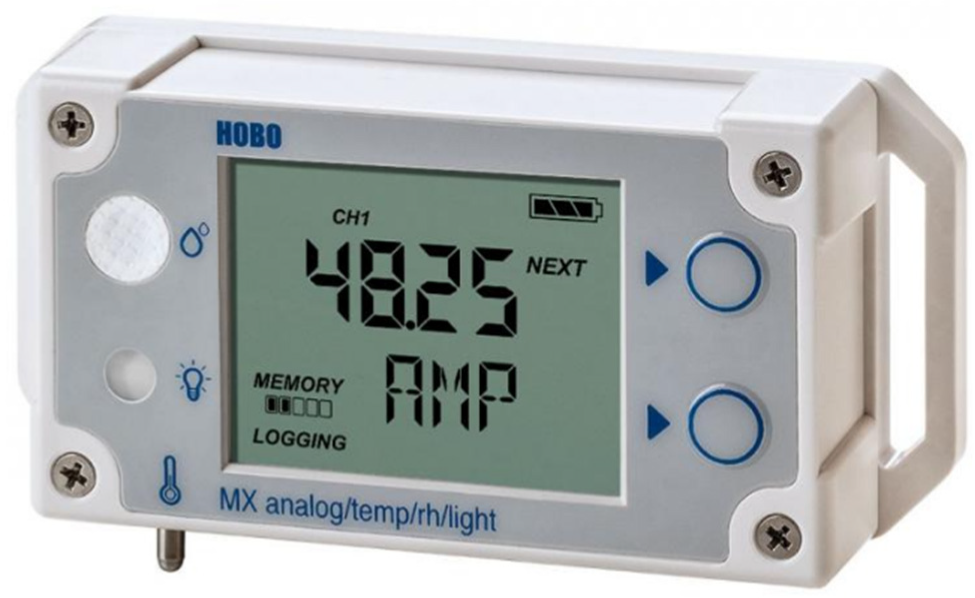
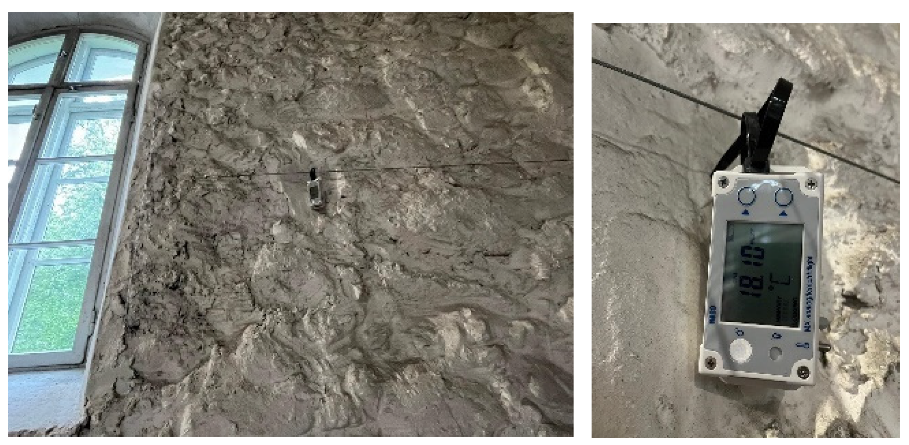
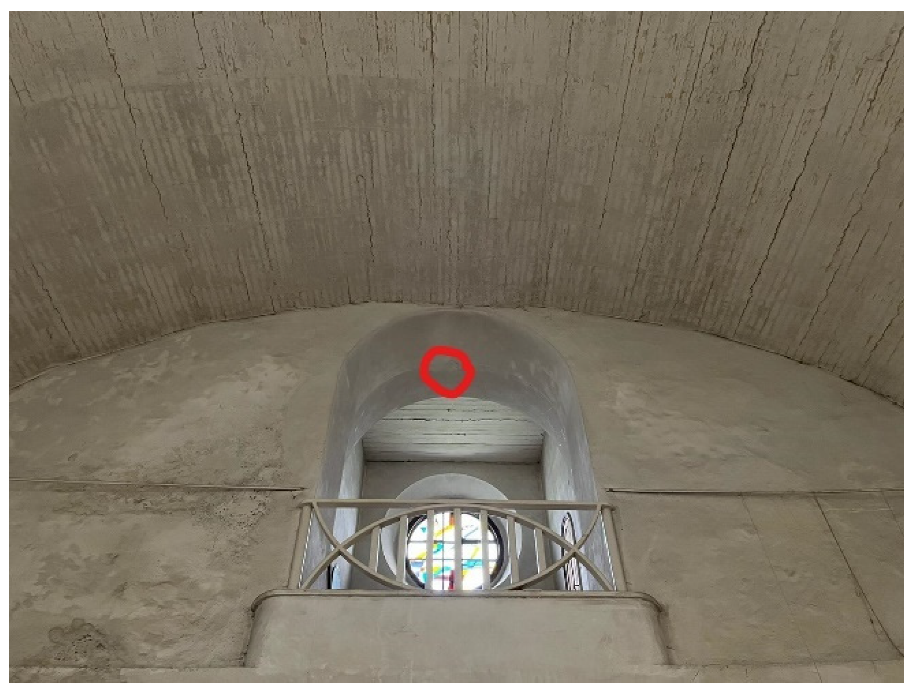

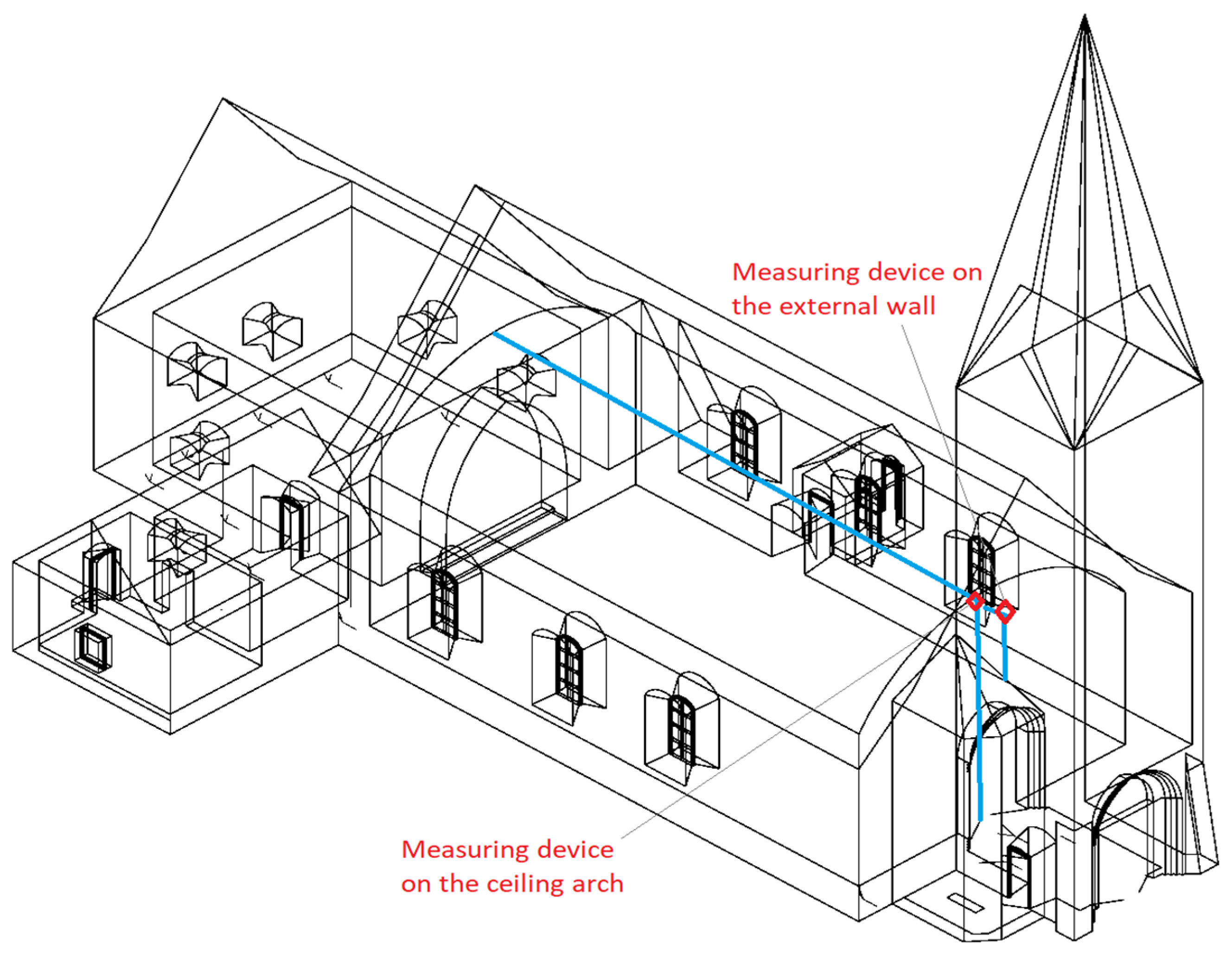


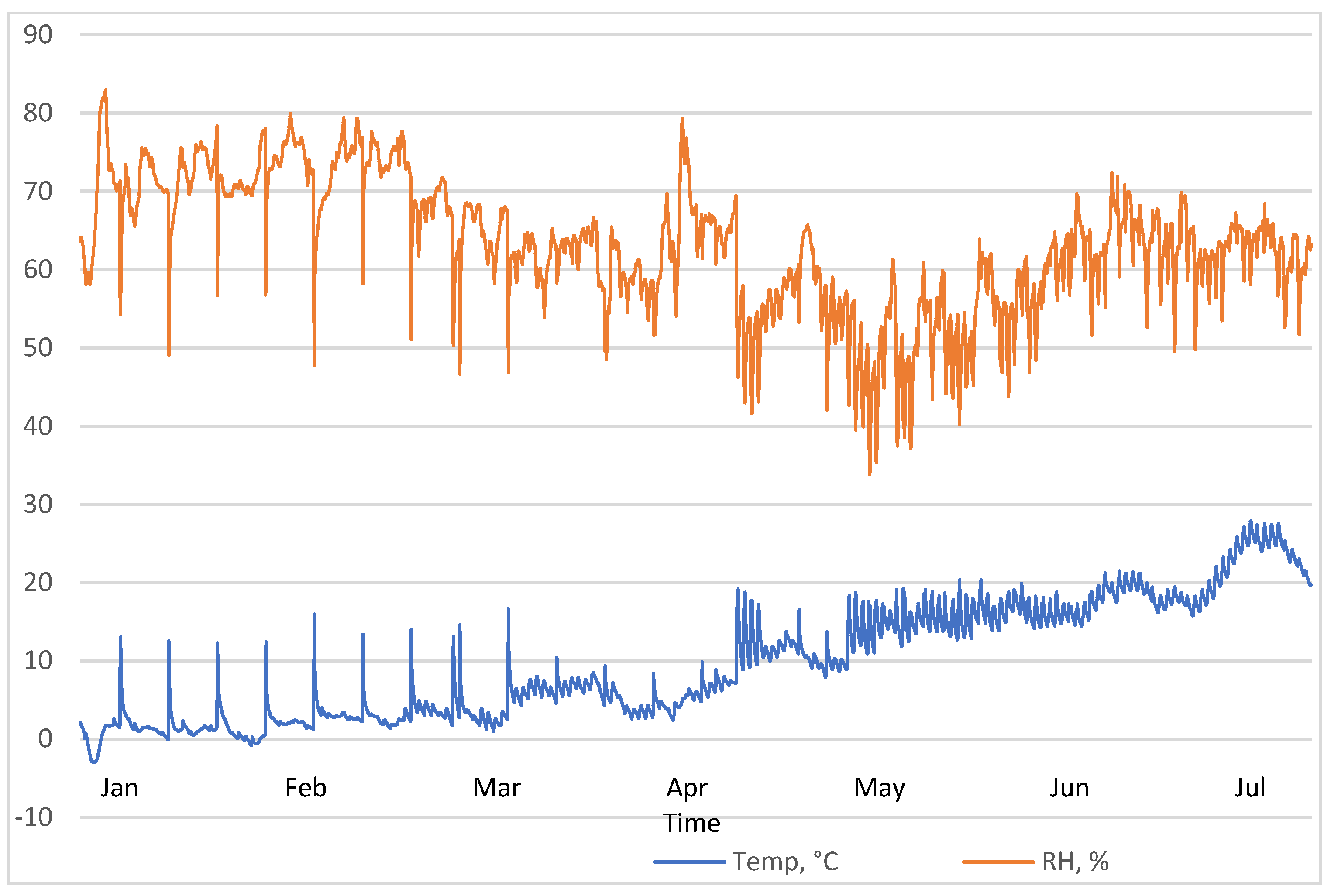

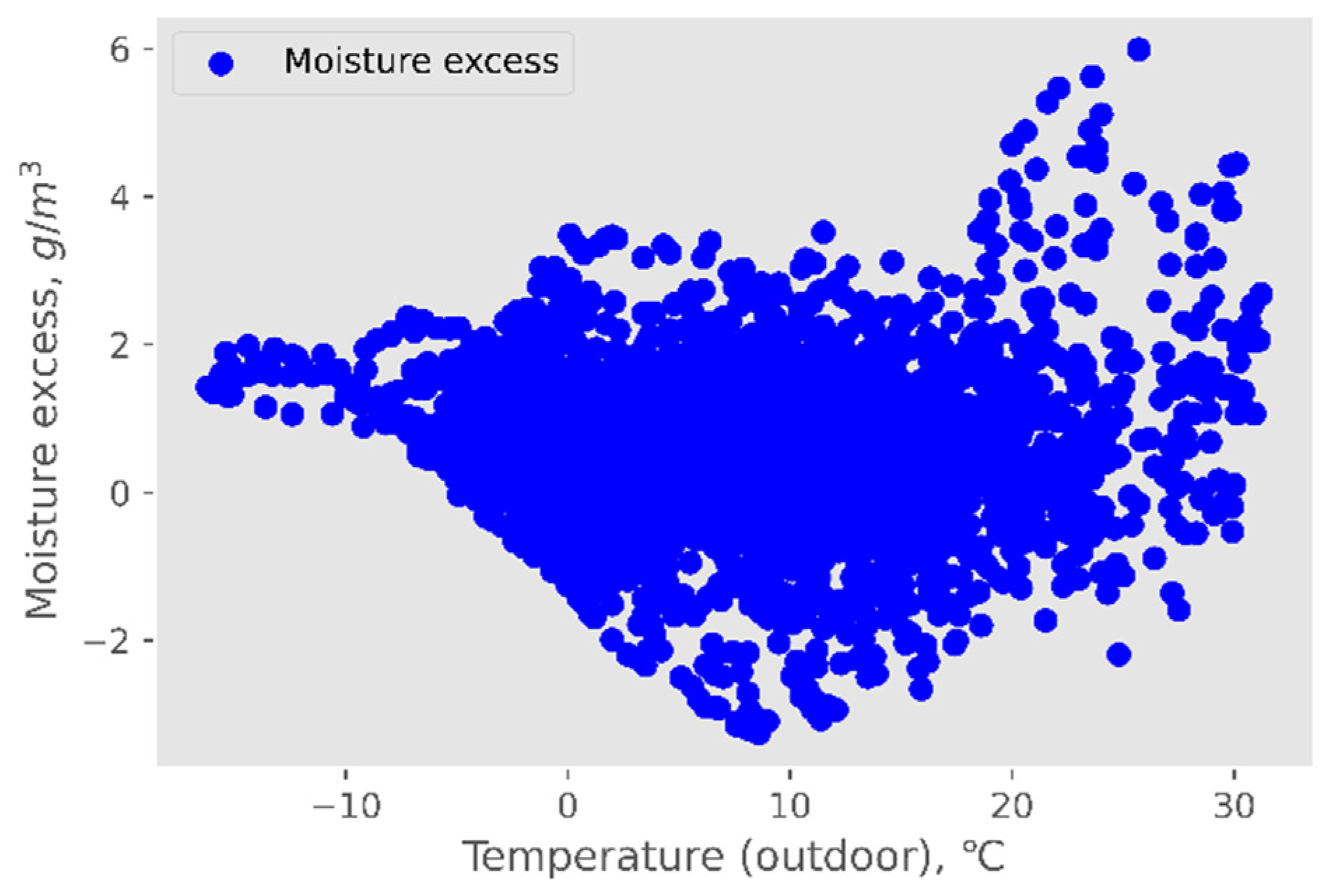
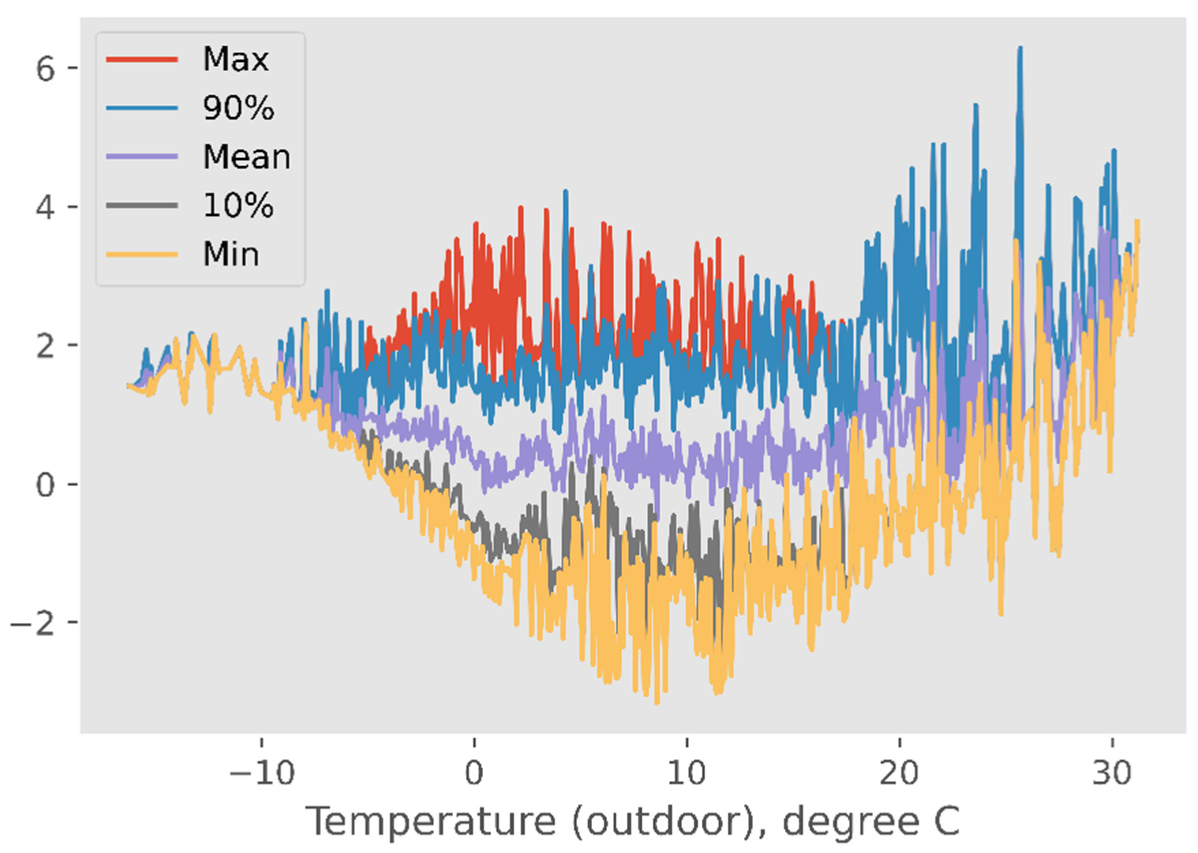
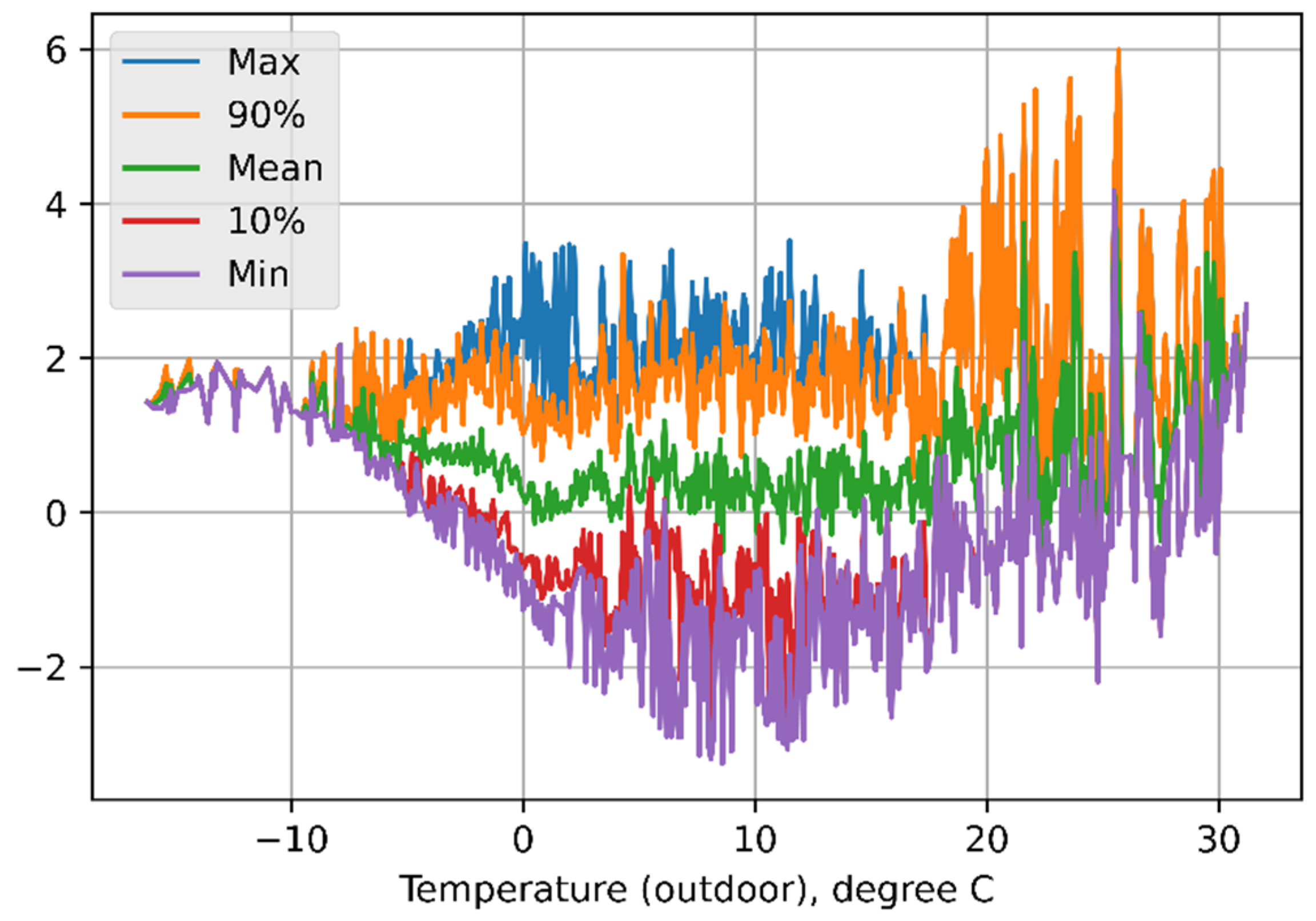
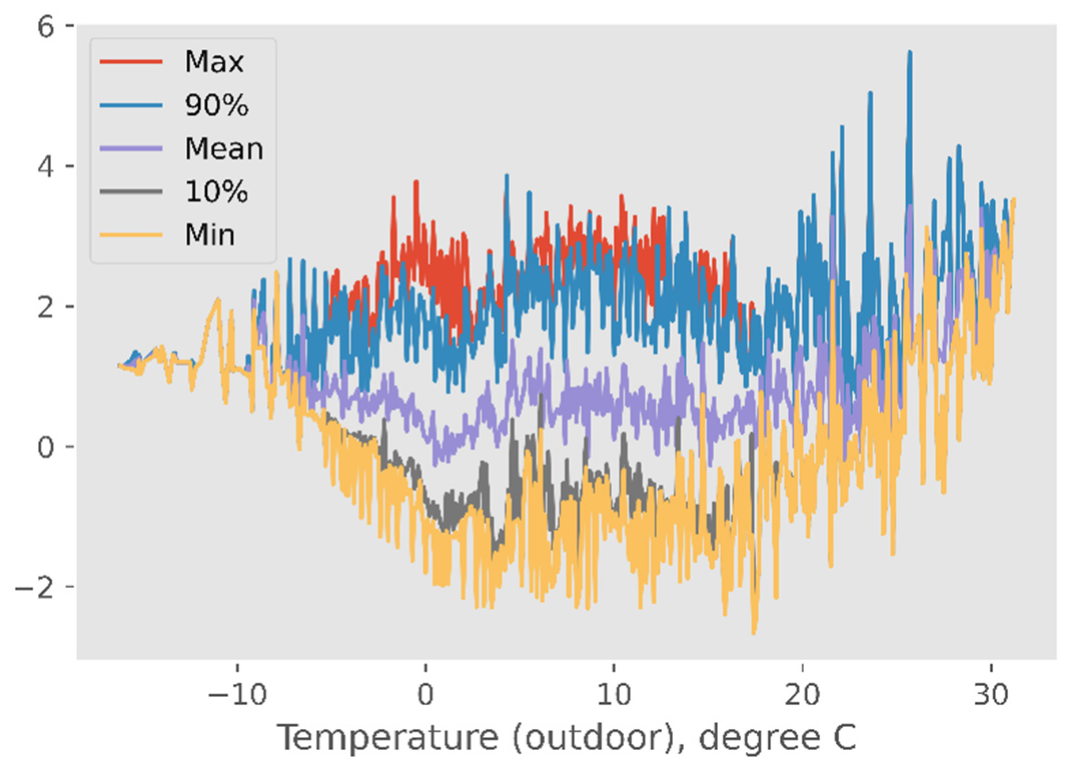
Publisher’s Note: MDPI stays neutral with regard to jurisdictional claims in published maps and institutional affiliations. |
© 2022 by the authors. Licensee MDPI, Basel, Switzerland. This article is an open access article distributed under the terms and conditions of the Creative Commons Attribution (CC BY) license (https://creativecommons.org/licenses/by/4.0/).
Share and Cite
Metals, M.; Palcikovskis, A.; Borodinecs, A.; Lesinskis, A. Typology of Latvian Churches and Preliminary Study on Indoor Air Temperature and Moisture Behavior. Buildings 2022, 12, 1396. https://doi.org/10.3390/buildings12091396
Metals M, Palcikovskis A, Borodinecs A, Lesinskis A. Typology of Latvian Churches and Preliminary Study on Indoor Air Temperature and Moisture Behavior. Buildings. 2022; 12(9):1396. https://doi.org/10.3390/buildings12091396
Chicago/Turabian StyleMetals, Martins, Arturs Palcikovskis, Anatolijs Borodinecs, and Arturs Lesinskis. 2022. "Typology of Latvian Churches and Preliminary Study on Indoor Air Temperature and Moisture Behavior" Buildings 12, no. 9: 1396. https://doi.org/10.3390/buildings12091396
APA StyleMetals, M., Palcikovskis, A., Borodinecs, A., & Lesinskis, A. (2022). Typology of Latvian Churches and Preliminary Study on Indoor Air Temperature and Moisture Behavior. Buildings, 12(9), 1396. https://doi.org/10.3390/buildings12091396







